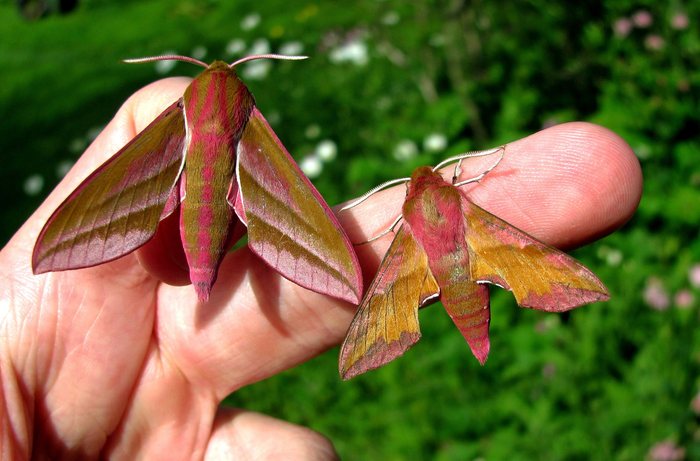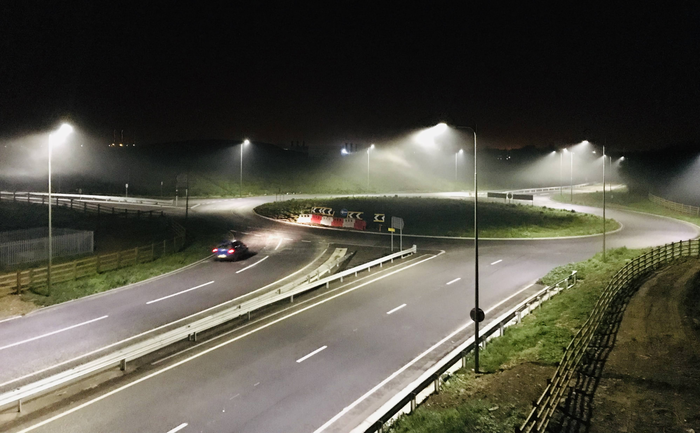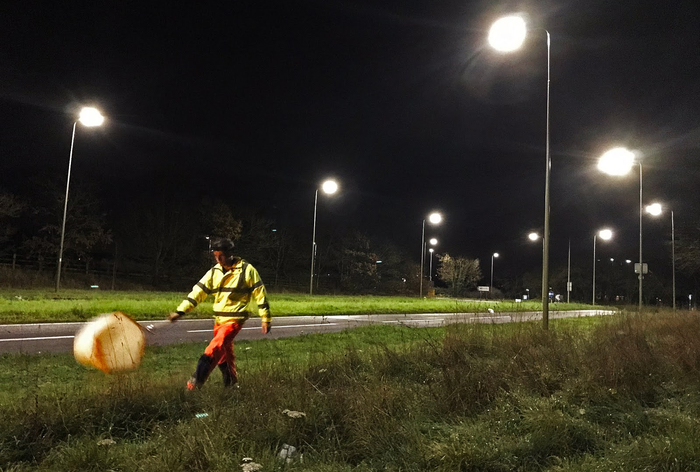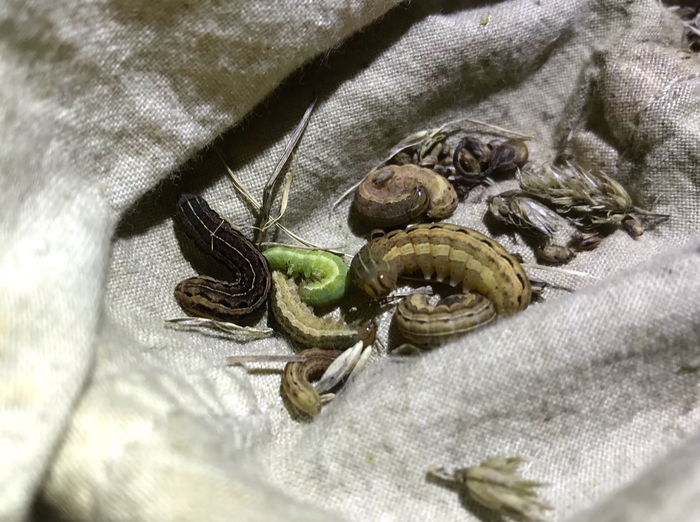Nighttime Streetlights Are Stressing Out Urban Insects
12:10 minutes

As insect populations—including bees, moths, and other pollinators—decline worldwide, researchers have established a variety of potential causes, including climate change, pesticides, and habitat loss. But now, new findings suggest yet another culprit may be part of the equation: night-time lighting, like street lights in populated areas.
A team of entomologists in the United Kingdom looked at populations of moth caterpillars under street lights, compared to populations that lived in darkness all night. In conditions with night-time lighting, they found nearly half as many caterpillars, in some cases. In addition, caterpillars that grew up under street lights were bigger, suggesting that they might be stressed and attempting to rush into metamorphosis earlier than they should. Furthermore, the greatest threat seems to be coming from energy-efficient LED lights, whose bluer wavelengths may be more stressful than the warmer, redder light of older sodium bulbs.


The team published their work in the journal Science Advances late last month. Guest host Umair Irfan talks to co-author Douglas Boyes about why nighttime lighting might be so bad for insects, and why ditching LED lights isn’t actually the best solution.

Douglas Boyes is a PhD researcher in the United Kingdom Centre for Ecology and Hydrology in Henley-on-Thames, UK.
UMAIR IRFAN: This is Science Friday. I’m Umair Irfan in for Ira Flatow. It’s been more than 15 years since beekeepers first started reporting mysterious waves of death in their hives over the winter. Now, colony collapse disorder as it’s now known is high on the list of threats to ecosystems and agriculture. But in the last few years, researchers have been sounding a new alarm about all insects.
One study in Germany in 2017 for example, found that flying insects had declined by as much as 75% in protected areas in the country. And researchers are seeing declines in butterfly and moth populations all over the world. The causes for this loss of insects include, habitat loss, climate change, and pesticide use. But new research published in the Journal Science advances last month investigated another possible culprit, artificial nighttime lighting like streetlights. One of the authors of that research is here to explain more. Douglas Boyes is a PhD researcher at the United Kingdom Center for Ecology and Hydrology. He joins us from Henley-on-Thames. Welcome to Science Friday Douglas.
DOUGLAS BOYES: Thank you. Thanks it’s great to be here.
UMAIR IRFAN: So this experiment you ran, you set up plots of land where you were looking at areas that were under streetlights and then you compare them to identical plots that had no lighting, and then you counted caterpillars. Tell us what you found.
DOUGLAS BOYES: So the most striking finding was just the sheer difference in the number of caterpillars. We found that they were up to half as many caterpillars in lit areas, between a half and a third as estimated by our statistical models. And really that’s a very striking reduction. We’re not really used to seeing even by that order of magnitude in ecology it’s usually five, 10% here and there, but to get half the number of insects due to this one factor it was really quite striking.
UMAIR IRFAN: And the caterpillars themselves they also seem to be bigger when they were under lights, is this a good sign?
DOUGLAS BOYES: Yeah, you might think that bigger caterpillars must have been the more healthy perhaps. We don’t think that’s the case. We don’t think it’s a good thing. And we think this is due to the caterpillars in lit areas being under stress. Essentially these caterpillars they’ve evolved for millions of years with completely dark nights, and now in these areas there’s essentially no nighttime perhaps. They don’t know how to respond to this new stressor in the environment, and what they’ll do is they’ll eat. They’ll develop very quickly.
So they’ll assume that there’s something wrong and invest in early [INAUDIBLE]. So they’ll try and fasten up as quickly as possible to get out of that stressful environment. And that’s something that’s been shown in some lab studies. So although they were heavier at the time of sampling when we’re comparing between the two pairs, lit and the unlit, we think that is simply because they are just rushed to their development just a little bit further ahead rather than it being a good thing.
UMAIR IRFAN: And does that have consequences for when those caterpillars eventually turn into moths?
DOUGLAS BOYES: Yeah, so in the laboratory studies that proceeded they found that they had faster development, but they pupated at a lower body mass, which would lead to smaller adults. And smaller adult wouldn’t be able to fly as far, perhaps the females certainly wouldn’t layer as many eggs so it’s expected to have negative fitness implications for the adults.
UMAIR IRFAN: You also ran an experiment where you set up new lighting in an area that didn’t have lights before, what did you see when that happened?
DOUGLAS BOYES: Yes, so we did this experiment looking at one of the groups of moths we were sampling that are nocturnal. So the caterpillars are nocturnal. Many people know most moths are nocturnal, but actually most of the caterpillars are nocturnal too. And we wanted to see whether in the very short term there was some sort of disruptive effect on their normal feeding behavior.
So they would spend their days at the base of long grass, and then only at night will they come up to feed, climb up these stems, and feed. So we installed these four meter light rigs, and we found that the caterpillars would only come up to feed in the unlit transects, and in the transect that were lit with sodium lighting. But there was a statistically significant negative effect under the White LEDs, which was the other streetlight we looked at.
UMAIR IRFAN: So just to reiterate, when caterpillars are first exposed to lighting they tend not to eat or eat a lot less. But as they get used to it, they start to stress eat and gain weight?
DOUGLAS BOYES: That’s what we think. They may be adapted or acclimated somehow at our long term sites. So they’ve sort of got used to the light to an extent that they can still feed but they do it in a stress eating way as you put it.
UMAIR IRFAN: You mentioned earlier that these fast growing caterpillars often lead to impaired adults, would the adult moths also have an impact from this lighting and their behavior?
DOUGLAS BOYES: Yeah, absolutely. I mean, the main one I guess is just this behavior of flying up to the light. People have observed moths flying around a streetlight and just sort of circling it until they die from exhaustion. I think a more significant source of mortality around street lights is from predation. Some species of bats will actively seek out streetlights, and they’ll just spend their whole night circling the streetlights on the sort of buffet of nocturnal flying insects that have been attracted to the light.
And all these insects, they failed to perform the usual behaviors that they would when they come in contact with bats. They can drop out of the sky when they hear a bat’s sonar and all sorts of things. But they just won’t do that. So they’re sort of sitting ducks, the bats will just have a feast.
UMAIR IRFAN: How about reproductive behavior? Does this also have impacts on how moths make more moths?
DOUGLAS BOYES: Yeah, absolutely. So in insects it’s very closely tied to the day/night cycle. If female Moths don’t have dark nights, if they are exposed to very low levels of light at night, their pheromones production is altered and that would reduce their capacity to attract a mate. And then in some male moths, the system through which they produce sperm is also disrupted. So they can essentially become infertile from lightning.
UMAIR IRFAN: And what about the moths in particular, are they particularly important? Do they play an important ecological role?
DOUGLAS BOYES: Yes. So I’m a big proponent of moths and not many people are so they need people to stick up for them. Moths are essentially butterflies with bad PR. They’re extremely important for prey. So the caterpillars that I were looking at they form an integral part of the diet of several species of songbird, and then the adults of course, I have already mentioned that the importance for bats. And all sorts of other mammals and invertebrates feed on moths.
The other important role that moths have, it’s one that’s been really rather overlooked, is their importance as pollinators. So pollination ecologists have tended to do their studies during the day, and maybe not stayed up all night. But actually over the last 10 years or so, as people have gone out at night, we’re beginning to appreciate that moths are really significant and important pollinators for our wildflowers and for some of our crops.
UMAIR IRFAN: Now, looking at the sources of light themselves you mentioned LED lights, which are these energy efficient bulbs that are largely replacing in many cities, those yellow sodium lamps, if they have a more detrimental effect on these moths then how do we balance that with the energy savings that we want?
DOUGLAS BOYES: The good thing about LEDs is that they are incredibly flexible in terms of the color of light that they produce which is one of the reasons why we think they might be worse for wildlife. But also in terms of things like dimming, part night lighting, motion sensors, that even this idea of smart street lighting where they’re all talking to each other and only on as vehicle to driving along the road. And all this is only really possible with LEDs. So we can hopefully begin to minimize these negative impacts on insects and on ecosystems, while still keeping all the benefits that lighting gives us.
UMAIR IRFAN: So with LEDs this is actually a fixable problem. Are there any particular colors or tuning adjustments that would be more ideal for moths that we could perhaps Institute into city ordinances?
DOUGLAS BOYES: Moths and indeed other nocturnal insects are much more sensitive to shorter wavelengths. So that’s the blue end of the rainbow. Specifically sensitive to ultraviolet light. So any streetlights with ultraviolet light would be most damaging, and it is generally don’t have UV light, they often have a lot of blue light. So what we would predict would be best is if those blue wavelengths can be reduced or cut out.
And what that would give you is a street light that resembles color those sorts of sodium lights that you mentioned. The sort of yellow, orange hues, and some studies have found different colored LEDs are good at mitigating the impacts on biodiversity, but other studies have shown that even sort of a monochromatic red. LED street light is just as harmful as a white one. So they would certainly help, but they might not solve the problem, or they won’t solve the whole problem.
UMAIR IRFAN: Now, while you found a significant effect with lighting, it seems like there’s still a lot of darkness out there across the world that urban areas still make up a small percentage of land overall. So how does this fit in within the broader picture of all the stresses insects face? How much of a difference would it make if we did in fact optimize lighting?
DOUGLAS BOYES: Yeah, that’s really good question. So this is something we tried to tackle in our study. For the study region it’s a gradient between sort of big city London and then the sort of more leafy countryside. And in that area which contains 160,000 streetlights, we estimated the lit area from those streetlights. It came to be about 1% of that landscape was lit. And then if we take out places like urban areas or the road surface which obviously isn’t habitat for insects, the percentages for things like arable land, or hedgerows, or woodlands, drops to fractions of a percentage.
So we think at the moment, the UK moths have been very well studied, they declined over 50 years. We think lighting is probably only at most made a minor contribution to these declines. But I guess what I would say is that if lighting is put in very sensitive areas, if we continue to urbanize at the rate we are, it could become a much more significant threat.
And then also the solutions are so tractable, they’re so accessible, they’re cheap, and they can be done without really taking away any of the benefits that lighting gives us. So if insects are in trouble as we believe they are, then perhaps we should be doing all we can to help them even if it’s not a silver bullet.
UMAIR IRFAN: That’s all the time we have. Thanks so much for being with us.
DOUGLAS BOYES: Thank you so much for having me.
UMAIR IRFAN: Douglas Boyes is a PhD researcher at the United Kingdom Center for Ecology and Hydrology. He joined us from Henley-on-Thames.
Copyright © 2021 Science Friday Initiative. All rights reserved. Science Friday transcripts are produced on a tight deadline by 3Play Media. Fidelity to the original aired/published audio or video file might vary, and text might be updated or amended in the future. For the authoritative record of Science Friday’s programming, please visit the original aired/published recording. For terms of use and more information, visit our policies pages at http://www.sciencefriday.com/about/policies/
Christie Taylor was a producer for Science Friday. Her days involved diligent research, too many phone calls for an introvert, and asking scientists if they have any audio of that narwhal heartbeat.